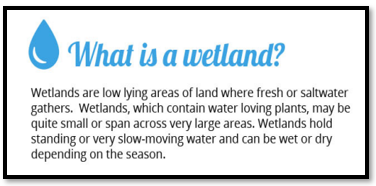SYLLAUBS
GS-3: Conservation, environmental pollution and degradation, environmental impact assessment.
Context:
Recently, India introduced a resolution on ‘Promoting Sustainable Lifestyles for the Wise Use of Wetlands’ at the Ramsar Conference of Parties (CoP) 15, held at Victoria Falls, Zimbabwe.
More on the News

- The resolution was backed by 172 contracting parties, six international organisation partners and other observers.
- It was adopted at the plenary session of the Conference of Parties.
About the Resolution
- The key purpose of the resolution is to promote individual and societal choices play in wetlands conservation, and work towards a pro-planet lifestyle, within their national circumstances and contexts.
- The resolution supports a ‘whole-of-society’ approach for wetland conservation, which refers to a comprehensive approach that involves engaging all sectors of a society.
- The resolution builds on Resolution 6/8 on “Promoting Sustainable Lifestyles” adopted at the Sixth UN Environment Assembly in March 2024.
- It also aligns with Resolution XIV.8 – New CEPA Approach (Communication, Education, and Public Awareness) and 10 years’ framework of programmes of Ramsar convention on ‘Sustainable production and consumption’.
- It urges voluntary action to consider the integration of sustainable lifestyles-based interventions in wetland management plans, programmes and investments at all levels.
- The resolution also calls for creating enabling conditions, fostering public-private collaboration and pursuing educational and awareness initiatives to enhance the wise use of wetlands.
Concept of Wise Use of Wetland
- The Ramsar Convention defines wise use of wetlands as “the maintenance of their ecological character, achieved through the implementation of ecosystem approaches, within the context of sustainable development”.
- Wise use can thus be seen as the conservation and sustainable use of wetlands and all the services they provide, for the benefit of people and nature.
Ramsar Convention on Wetlands
- It is an international treaty that provides the framework for the conservation and wise use of wetlands and their resources globally.
- The Convention was adopted in the Iranian city of Ramsar in 1971 and came into force in 1975.
- India joined the Ramsar Convention in 1982 and has designated 91 wetlands under its national programme.
- Every three years the Contracting Parties meet at the Conference of the Parties (COP) to set the work programme and budget for the next three years and address ongoing and emerging environmental issues.
- World Wetlands Day, celebrated annually on 2 February, aims to raise global awareness of the vital role of wetlands for people, nature and culture.
- This year’s theme, is ‘Protecting Wetlands for Our Common Future’,
Ramsar Sites in India
- India acceded to the Ramsar Convention on Wetlands on February 1, 1982.
- Currently India has 91 wetlands, the highest number of Ramsar sites in Asia and third highest in the world after the United Kingdom (176), and Mexico (144).
- Tamil Nadu has the highest number of Ramsar Sites in India, with 20 designated wetlands, followed by Uttar Pradesh with 10.
- These wetlands are protected under various national laws, including the Indian Forest Act (1927), the Forest (Conservation) Act (1980), the Environment (Protection) Act, 1986, and the Indian Wildlife (Protection) Act (1972).
Source



